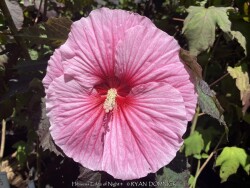

Hardy Hibiscus are US native plants that feature very large single petal flowers sometimes as large as a dinner plate. Colors include white, pink, red, magenta, purple with many different combinations. Foliage can range from green to reddish to dark purplish black. Hardy hibiscus breeding to produce improved cultivars has come a long way in the last 10 or 20 years. Hibiscus emerge later than most other perennials, needing the ground to heat up before growing in May. Hibiscus tolerate a wide range of soil conditions including clay and wetness but prefer rich garden soil. Drought is tolerated with established plants although flowering will be reduced. Generally, the 40 inches of rainfall in Eastern Kansas is sufficient. Full sun is best for optimal foliage coloring, growth habit, and flowers. When used in a landscape, hibiscus brings a tropical feel when flowering and are noticeable from very far away. Combine with hardy bananas (musa basjoo) and other contrasting flowers. Groupings of hibiscus are very effective around water gardens, rain gardens, backyard fences, pollinator gardens, and roadside areas where you only have a second to look when driving by. Modern hibiscus cultivars do not set seed and do not need to be deadheaded like old varieties; the result is continuous blooming from July till September. Cool autumn nights below 50 degrees F initiate beautiful fall foliage colors ranging from red and purple to fiery orange. Maintenance is pretty easy: just cut down dead stocks to the ground at some point in fall or winter. A yearly time-release fertilizer is appreciated from most heavily flowering plants. There are some occasional foliage pests for hibiscuses including leaf miners, grasshoppers, and Japanese beetles but these can be treated. If not treated, it generally won't kill the plant, especially if the plant is otherwise healthy and in good growing conditions. Hibiscus 'Dark Mystery' is a Walters Gardens Inc. introduction. Incredibly dark, wine purple foliage contrasts beautiful with the large 8-9" white flowers. Each flower has a cherry red eye and dark pink veining. Heart-shaped leaves cover the round habit.
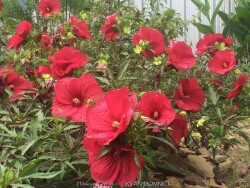

Hardy Hibiscus are US native plants that feature very large single petal flowers sometimes as large as a dinner plate. Colors include white, pink, red, magenta, purple with many different combinations. Foliage can range from green to reddish to dark purplish black. Hardy hibiscus breeding to produce improved cultivars has come a long way in the last 10 or 20 years. Hibiscus emerge later than most other perennials, needing the ground to heat up before growing in May. Hibiscus tolerate a wide range of soil conditions including clay and wetness but prefer rich garden soil. Drought is tolerated with established plants although flowering will be reduced. Generally, the 40 inches of rainfall in Eastern Kansas is sufficient. Full sun is best for optimal foliage coloring, growth habit, and flowers. When used in a landscape, hibiscus brings a tropical feel when flowering and are noticeable from very far away. Combine with hardy bananas (musa basjoo) and other contrasting flowers. Groupings of hibiscus are very effective around water gardens, rain gardens, backyard fences, pollinator gardens, and roadside areas where you only have a second to look when driving by. Modern hibiscus cultivars do not set seed and do not need to be deadheaded like old varieties; the result is continuous blooming from July till September. Cool autumn nights below 50 degrees F initiate beautiful fall foliage colors ranging from red and purple to fiery orange. Maintenance is pretty easy: just cut down dead stocks to the ground at some point in fall or winter. A yearly time-release fertilizer is appreciated from most heavily flowering plants. There are some occasional foliage pests for hibiscuses including leaf miners, grasshoppers, and Japanese beetles but these can be treated. If not treated, it generally won't kill the plant, especially if the plant is otherwise healthy and in good growing conditions. Fireball Hardy Hibiscus (Hibiscus 'Fireball') was developed by the Fleming Brothers of Lincoln, Nebraska. It features dark red, funnel-shaped flowers that are a whopping 9-10 inches across with a deep burgundy center. The lobed leaves resemble maple leaves; they feature a solid green with red veins and an attractive purple tint. This variety can tolerate 1/2 shade and still bloom well!
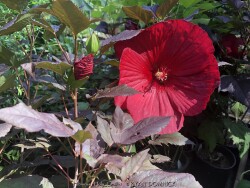

Hardy Hibiscus are US native plants that feature very large single petal flowers sometimes as large as a dinner plate. Colors include white, pink, red, magenta, purple with many different combinations. Foliage can range from green to reddish to dark purplish black. Hardy hibiscus breeding to produce improved cultivars has come a long way in the last 10 or 20 years. Hibiscus emerge later than most other perennials, needing the ground to heat up before growing in May. Hibiscus tolerate a wide range of soil conditions including clay and wetness but prefer rich garden soil. Drought is tolerated with established plants although flowering will be reduced. Generally, the 40 inches of rainfall in Eastern Kansas is sufficient. Full sun is best for optimal foliage coloring, growth habit, and flowers. When used in a landscape, hibiscus brings a tropical feel when flowering and are noticeable from very far away. Combine with hardy bananas (musa basjoo) and other contrasting flowers. Groupings of hibiscus are very effective around water gardens, rain gardens, backyard fences, pollinator gardens, and roadside areas where you only have a second to look when driving by. Modern hibiscus cultivars do not set seed and do not need to be deadheaded like old varieties; the result is continuous blooming from July till September. Cool autumn nights below 50 degrees F initiate beautiful fall foliage colors ranging from red and purple to fiery orange. Maintenance is pretty easy: just cut down dead stocks to the ground at some point in fall or winter. A yearly time-release fertilizer is appreciated from most heavily flowering plants. There are some occasional foliage pests for hibiscuses including leaf miners, grasshoppers, and Japanese beetles but these can be treated. If not treated, it generally won't kill the plant, especially if the plant is otherwise healthy and in good growing conditions. Summerific® 'Holy Grail' Rose Mallow (Hibiscus 'Holy Grail') is a Walters Gardens Inc. introduction. This is truly a special Hardy Hibiscus. Incredibly dark, near-black foliage hold 8-9" deep red flowers. Use as a focal point to your garden and be delighted in mid to late summer. All Proven Winners® plants are legally propagated, healthy and vigorous, true to name, and tagged with color pictures and growing information.
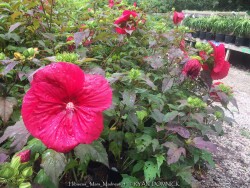

Hardy Hibiscus are US native plants that feature very large single petal flowers sometimes as large as a dinner plate. Colors include white, pink, red, magenta, purple with many different combinations. Foliage can range from green to reddish to dark purplish black. Hardy hibiscus breeding to produce improved cultivars has come a long way in the last 10 or 20 years. Hibiscus emerge later than most other perennials, needing the ground to heat up before growing in May. Hibiscus tolerate a wide range of soil conditions including clay and wetness but prefer rich garden soil. Drought is tolerated with established plants although flowering will be reduced. Generally, the 40 inches of rainfall in Eastern Kansas is sufficient. Full sun is best for optimal foliage coloring, growth habit, and flowers. When used in a landscape, hibiscus brings a tropical feel when flowering and are noticeable from very far away. Combine with hardy bananas (musa basjoo) and other contrasting flowers. Groupings of hibiscus are very effective around water gardens, rain gardens, backyard fences, pollinator gardens, and roadside areas where you only have a second to look when driving by. Modern hibiscus cultivars do not set seed and do not need to be deadheaded like old varieties; the result is continuous blooming from July till September. Cool autumn nights below 50 degrees F initiate beautiful fall foliage colors ranging from red and purple to fiery orange. Maintenance is pretty easy: just cut down dead stocks to the ground at some point in fall or winter. A yearly time-release fertilizer is appreciated from most heavily flowering plants. There are some occasional foliage pests for hibiscuses including leaf miners, grasshoppers, and Japanese beetles but these can be treated. If not treated, it generally won't kill the plant, especially if the plant is otherwise healthy and in good growing conditions. Hibiscus 'Mars Madness' is a Walters Gardens Inc. introduction. Dark olive green leaves have copper highlights, with the newest leaves emerging coppery purple. The large, maple-like leaves are broadly smooth and form a full, billowy habit. Huge 6-8" flowers open flat and are magenta red in color, more on the pink side of the spectrum than 'Cranberry Crush'. Each flower has a small, darker red halo with overlapping petals and deeply impressed veins. Flowers are produced from the top to the bottom of the plant, rather than only at the top like some older cultivars.
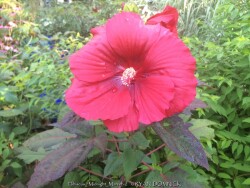

Hardy Hibiscus are US native plants that feature very large single petal flowers sometimes as large as a dinner plate. Colors include white, pink, red, magenta, purple with many different combinations. Foliage can range from green to reddish to dark purplish black. Hardy hibiscus breeding to produce improved cultivars has come a long way in the last 10 or 20 years. Hibiscus emerge later than most other perennials, needing the ground to heat up before growing in May. Hibiscus tolerate a wide range of soil conditions including clay and wetness but prefer rich garden soil. Drought is tolerated with established plants although flowering will be reduced. Generally, the 40 inches of rainfall in Eastern Kansas is sufficient. Full sun is best for optimal foliage coloring, growth habit, and flowers. When used in a landscape, hibiscus brings a tropical feel when flowering and are noticeable from very far away. Combine with hardy bananas (musa basjoo) and other contrasting flowers. Groupings of hibiscus are very effective around water gardens, rain gardens, backyard fences, pollinator gardens, and roadside areas where you only have a second to look when driving by. Modern hibiscus cultivars do not set seed and do not need to be deadheaded like old varieties; the result is continuous blooming from July till September. Cool autumn nights below 50 degrees F initiate beautiful fall foliage colors ranging from red and purple to fiery orange. Maintenance is pretty easy: just cut down dead stocks to the ground at some point in fall or winter. A yearly time-release fertilizer is appreciated from most heavily flowering plants. There are some occasional foliage pests for hibiscuses including leaf miners, grasshoppers, and Japanese beetles but these can be treated. If not treated, it generally won't kill the plant, especially if the plant is otherwise healthy and in good growing conditions. Hibiscus 'Midnight Marvel' is a Walters Gardens Inc. introduction. This variety combines the deep wine-purple, maple-like foliage of 'Perfect Storm' and the scarlet red, 8-9" flowers of 'Cranberry Crush'. From 'Cranberry Crush', it inherits very similar glossy, black-red buds which open to 8-9", deep scarlet red flowers. The habit is relatively compact, measuring in at 4' tall x 4½' wide. Since this variety is an indeterminate bloomer (has buds at several nodes up the stem), it blooms for an extended period from midsummer into early fall. All-day full sun is needed for dark foliage color.
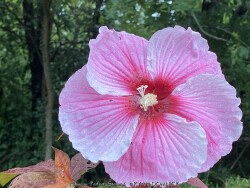

Hardy Hibiscus are US native plants that feature very large single petal flowers sometimes as large as a dinner plate. Colors include white, pink, red, magenta, purple with many different combinations. Foliage can range from green to reddish to dark purplish black. Hardy hibiscus breeding to produce improved cultivars has come a long way in the last 10 or 20 years. Hibiscus emerge later than most other perennials, needing the ground to heat up before growing in May. Hibiscus tolerate a wide range of soil conditions including clay and wetness but prefer rich garden soil. Drought is tolerated with established plants although flowering will be reduced. Generally, the 40 inches of rainfall in Eastern Kansas is sufficient. Full sun is best for optimal foliage coloring, growth habit, and flowers. When used in a landscape, hibiscus brings a tropical feel when flowering and are noticeable from very far away. Combine with hardy bananas (musa basjoo) and other contrasting flowers. Groupings of hibiscus are very effective around water gardens, rain gardens, backyard fences, pollinator gardens, and roadside areas where you only have a second to look when driving by. Modern hibiscus cultivars do not set seed and do not need to be deadheaded like old varieties; the result is continuous blooming from July till September. Cool autumn nights below 50 degrees F initiate beautiful fall foliage colors ranging from red and purple to fiery orange. Maintenance is pretty easy: just cut down dead stocks to the ground at some point in fall or winter. A yearly time-release fertilizer is appreciated from most heavily flowering plants. There are some occasional foliage pests for hibiscuses including leaf miners, grasshoppers, and Japanese beetles but these can be treated. If not treated, it generally won't kill the plant, especially if the plant is otherwise healthy and in good growing conditions. Summerific® 'Perfect Storm' Rose Mallow(Hibiscus 'Perfect Storm') is a Walters Gardens Inc. introduction. A naturally compact selection that works well in large containers. Large 7-8", white flowers with a red eye are produced all over the dense, rounded clump of deep black-purple maple-like leaves. All Proven Winners® plants are legally propagated, healthy and vigorous, true to name, and tagged with color pictures and growing information.
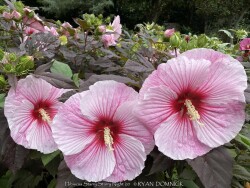

Hardy Hibiscus are US native plants that feature very large single petal flowers sometimes as large as a dinner plate. Colors include white, pink, red, magenta, purple with many different combinations. Foliage can range from green to reddish to dark purplish black. Hardy hibiscus breeding to produce improved cultivars has come a long way in the last 10 or 20 years. Hibiscus emerge later than most other perennials, needing the ground to heat up before growing in May. Hibiscus tolerate a wide range of soil conditions including clay and wetness but prefer rich garden soil. Drought is tolerated with established plants although flowering will be reduced. Generally, the 40 inches of rainfall in Eastern Kansas is sufficient. Full sun is best for optimal foliage coloring, growth habit, and flowers. When used in a landscape, hibiscus brings a tropical feel when flowering and are noticeable from very far away. Combine with hardy bananas (musa basjoo) and other contrasting flowers. Groupings of hibiscus are very effective around water gardens, rain gardens, backyard fences, pollinator gardens, and roadside areas where you only have a second to look when driving by. Modern hibiscus cultivars do not set seed and do not need to be deadheaded like old varieties; the result is continuous blooming from July till September. Cool autumn nights below 50 degrees F initiate beautiful fall foliage colors ranging from red and purple to fiery orange. Maintenance is pretty easy: just cut down dead stocks to the ground at some point in fall or winter. A yearly time-release fertilizer is appreciated from most heavily flowering plants. There are some occasional foliage pests for hibiscuses including leaf miners, grasshoppers, and Japanese beetles but these can be treated. If not treated, it generally won't kill the plant, especially if the plant is otherwise healthy and in good growing conditions. Hibiscus 'Starry Starry Night' is a Walters Gardens Inc. introduction. Incredibly dark, near-black, broad, maple-like leaves form an upright clump in the landscape. Interesting 7-8" flowers are pale pink with darker pink speckling and veining. The flowers are held on bright green carpels, which contrast nicely with the dark foliage. Flowers are produced from the top to the bottom of the plant, rather than only at the top like some older cultivars.
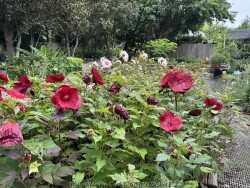

Hardy Hibiscus are US native plants that feature very large single petal flowers sometimes as large as a dinner plate. Colors include white, pink, red, magenta, purple with many different combinations. Foliage can range from green to reddish to dark purplish black. Hardy hibiscus breeding to produce improved cultivars has come a long way in the last 10 or 20 years. Hibiscus emerge later than most other perennials, needing the ground to heat up before growing in May. Hibiscus tolerate a wide range of soil conditions including clay and wetness but prefer rich garden soil. Drought is tolerated with established plants although flowering will be reduced. Generally, the 40 inches of rainfall in Eastern Kansas is sufficient. Full sun is best for optimal foliage coloring, growth habit, and flowers. When used in a landscape, hibiscus brings a tropical feel when flowering and are noticeable from very far away. Combine with hardy bananas (musa basjoo) and other contrasting flowers. Groupings of hibiscus are very effective around water gardens, rain gardens, backyard fences, pollinator gardens, and roadside areas where you only have a second to look when driving by. Modern hibiscus cultivars do not set seed and do not need to be deadheaded like old varieties; the result is continuous blooming from July till September. Cool autumn nights below 50 degrees F initiate beautiful fall foliage colors ranging from red and purple to fiery orange. Maintenance is pretty easy: just cut down dead stocks to the ground at some point in fall or winter. A yearly time-release fertilizer is appreciated from most heavily flowering plants. There are some occasional foliage pests for hibiscuses including leaf miners, grasshoppers, and Japanese beetles but these can be treated. If not treated, it generally won't kill the plant, especially if the plant is otherwise healthy and in good growing conditions. Hibiscus 'Valentines Crush' is a Walters Gardens Inc. introduction. According to Walters Gardens, "Love is in the air with this new cherry red Hardy Hibiscus from Proven Winners®! 'Valentine's Crush' replaces 'Cranberry Crush' in the SUMMERIFIC® Collection. Compared with 'Cranberry Crush', this variety has brighter red flowers that open fully flat at 7-8" wide. The leaves have a large, ovate shape - causing the plant to have a full appearance - and a dark bronze cast in full sun"


Hardy Hibiscus are US native plants that feature very large single petal flowers sometimes as large as a dinner plate. Colors include white, pink, red, magenta, purple with many different combinations. Foliage can range from green to reddish to dark purplish black. Hardy hibiscus breeding to produce improved cultivars has come a long way in the last 10 or 20 years. Hibiscus emerge later than most other perennials, needing the ground to heat up before growing in May. Hibiscus tolerate a wide range of soil conditions including clay and wetness but prefer rich garden soil. Drought is tolerated with established plants although flowering will be reduced. Generally, the 40 inches of rainfall in Eastern Kansas is sufficient. Full sun is best for optimal foliage coloring, growth habit, and flowers. When used in a landscape, hibiscus brings a tropical feel when flowering and are noticeable from very far away. Combine with hardy bananas (musa basjoo) and other contrasting flowers. Groupings of hibiscus are very effective around water gardens, rain gardens, backyard fences, pollinator gardens, and roadside areas where you only have a second to look when driving by. Modern hibiscus cultivars do not set seed and do not need to be deadheaded like old varieties; the result is continuous blooming from July till September. Cool autumn nights below 50 degrees F initiate beautiful fall foliage colors ranging from red and purple to fiery orange. Maintenance is pretty easy: just cut down dead stocks to the ground at some point in fall or winter. A yearly time-release fertilizer is appreciated from most heavily flowering plants. There are some occasional foliage pests for hibiscuses including leaf miners, grasshoppers, and Japanese beetles but these can be treated. If not treated, it generally won't kill the plant, especially if the plant is otherwise healthy and in good growing conditions. Hibiscus 'Vintage Wine' is a Walters Gardens Inc. introduction. Near-black buds open to huge 7", scarlet red flowers that shimmer in the sun with a darker red eye. The overlapping petals of 'Vintage Wine' have a crinkled texture and open completely with minimal cupping. Flowers are produced from the top to the bottom of the plant, rather than only at the top like some older cultivars. Dark green, heart-shaped leaves form a densely upright, columnar clump.
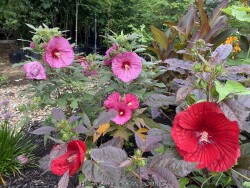

Hardy Hibiscus are US native plants that feature very large single petal flowers sometimes as large as a dinner plate. Colors include white, pink, red, magenta, purple with many different combinations. Foliage can range from green to reddish to dark purplish black. Hardy hibiscus breeding to produce improved cultivars has come a long way in the last 10 or 20 years. Hibiscus emerge later than most other perennials, needing the ground to heat up before growing in May. Hibiscus tolerate a wide range of soil conditions including clay and wetness but prefer rich garden soil. Drought is tolerated with established plants although flowering will be reduced. Generally, the 40 inches of rainfall in Eastern Kansas is sufficient. Full sun is best for optimal foliage coloring, growth habit, and flowers. When used in a landscape, hibiscus brings a tropical feel when flowering and are noticeable from very far away. Combine with hardy bananas (musa basjoo) and other contrasting flowers. Groupings of hibiscus are very effective around water gardens, rain gardens, backyard fences, pollinator gardens, and roadside areas where you only have a second to look when driving by. Modern hibiscus cultivars do not set seed and do not need to be deadheaded like old varieties; the result is continuous blooming from July till September. Cool autumn nights below 50 degrees F initiate beautiful fall foliage colors ranging from red and purple to fiery orange. Maintenance is pretty easy: just cut down dead stocks to the ground at some point in fall or winter. A yearly time-release fertilizer is appreciated from most heavily flowering plants. There are some occasional foliage pests for hibiscuses including leaf miners, grasshoppers, and Japanese beetles but these can be treated. If not treated, it generally won't kill the plant, especially if the plant is otherwise healthy and in good growing conditions.
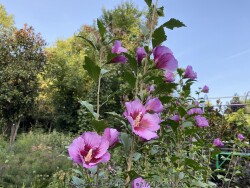

You've never seen a Rose Of Sharon like this before! Purple Pillar® (Hibiscus syriacus 'Purple Pillar') is a totally unique Rose Of Sharon: it naturally grows as a narrow column instead of a wide, spreading plant. It gets to be just 2-3' (.6-.9 m) wide and 10-16' tall! Think of what you could do with that: screens, hedges, patio containers. Anywhere you need a little privacy and/or color in a narrow space, this plant is a great choice. Like most all hibiscus, it will do best in full sun. It is hardy to USDA Zone 5. In summer, each stem is packed along its entire length with purple blooms. This unusual columnar habit makes it a real space saver - if you thought you didn't have enough space to grow Rose Of Sharon, Purple Pillar is perfect for you. Try it in containers, or flanking your front door, or simply as a quirky accent in your landscape. The narrow habit of Purple Pillar Rose Of Sharon means it creates few to no branches, so little to no pruning is required. If you want to prune it, do so in early spring. In areas that experience snowfall, avoid planting it where it might be dumped on by snow falling off of the roof - yours, or your neighbors. In Eastern Kansas, this cultivar performs WELL with just about everything nature has to challenge it! Heat and drought are tolerated full sun or part shade. Our typical 40 inches of rainfall is sufficient without extra water if planted in good soils. Cold tolerance is no problem. No disease or pest problems. Only issue is that seeds will form and re-seeding does not coming true to form: we recommend spraying round-up as seedling appear around the base of the original true Purple Pillar shrubs. You don't want any "non-pillar" wild troublemakers messing up your line. All Proven Winners® plants are legally propagated, healthy and vigorous, true to name, and tagged with color pictures and growing information.
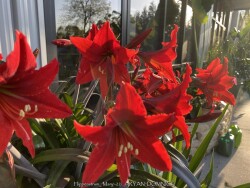

Mary's Hardy Red Amaryllis (Hippeastrum 'Mary') is a cultivar named by Ryan Domnick after his mother Mary. Mary Domnick had grown this beautiful unknown variety for over a decade in the 1980's and 1990's. The glossy green strap-like leaves emerge in spring emerge with a reddish tint. Deep red velvety flowers have a darker red throat and last for about a month. Foliage remains attractive all summer with plenty of heat tolerance. No other cultivars match this pure deep red color! The plants are temperate and subtropical herbaceous perennial bulbs native to areas with a summer wet season and dry winter. Mary's Hardy Red Amaryllis are hardy outside as a perennial when established and mulched at least to zone 6a. During the growing season, fertilize, water regularly, and plant in full sun. Plant these bulbs in the ground at least 6-8" deep with 3-4" of mulch to enjoy a wonderful tropical flowering effect! Trim back foliage after first fall freeze. They can also be grown as a flowering summer patio plant. If growing as a potted plant and trying to overwinter, allowing the foliage to frost is ok, it will not kill the root system. However, do not allow the pot with rootball to freeze solid or go below 20 degrees for more than a few hours; move into a cold garage or basement over the winter with no watering. Cut back and allow to go dormant and place entire pot back out in April or May with a time-release fertilizer. Another more labor intensive way to overwinter gladiolus is to remove them from the dirt, dust with fungicide, place in box with sawdust, and keep in the refrigerator. We consider this method old-fashioned and too much work but ok if you only want to save a few bulbs. If digging from the ground in colder zones, just save a big chunk with the dirt intact and place into a large pot in the garage. In our display garden in Lawrence, KS (zone 6a), several established specimens planted over 4-6" deep and mulched 2-3" with wood mulch survived -17 degrees F. During the arctic blast of February, 2021, lows down to -17 degrees F on Feb 16th, 2021 were recorded. The longevity of this cold blast was also impressive: 10 days on a row with highs of 10-15 degrees F or lower, 8 nights of lows in the single digits and negatives, and 36 straight hours of 0 degrees F and mostly lower. These have been in the ground for over 10 years and muscled through other periods of below zero cold weather.
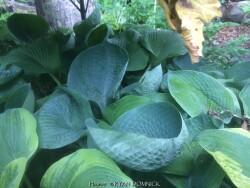

Hosta by far is the most popular and well-known shade plant in the United States. Many thousands of cultivars exist from original species native to China, Japan, and other forested areas in Asia. Hosta foliage arises from a clump-forming root system and is often large and dramatic with many types of variegation. Flowers, born on tall stocks ranging in shades of white and purple, are equally attractive. Hostas grow best in rich, well-drained soils in full to partial shade. In Eastern Kansas with our average 40 inches of average rainfall, plants are drought tolerant if established in moisture-retentive high-quality soil. Dry-shade areas are best avoided. Afternoon sun with temperatures over 95 degrees F but likely burn the tips of hosta foliage rendering them unattractive for the rest of the year. There is no secondary growth by late summer after flowering and after buds have been set for next year. In northern parts of the country, hostas can handle full sun. In the Southern part of their range further South than zone 7, hosta can really struggle through the long summer heat unless conditions are perfect. Rabbits, deer, slugs, and snails can be a problem generally on small or un-established plants. Large-leaf robust varieties seem to outgrow browsing predators better than small dainty varieties. Methods of control are effective ranging from cages to deer repellents. Generally, a large established planting of hostas will be there for decades gradually getting thicker and denser without a need to divide. Many plantings have been in our display garden for 15-20 years with no weeds ever trying to grow in the shade of the foliage. Hosta foliage is susceptible to late spring freezes so try to cover if possible. During the Easter freeze of April, 2007, thousands of hosta were killed to the ground in eastern Kansas but all returned successfully by May from secondary buds. Hosta's newly unfurling foliage is considered edible when cooked like asparagus or eaten raw in salads. Hosta 'Abiqua Drinking Gourd' is a medium (large) puckered, powder-blue leaves with chalky undersides are uniquely upward facing and deeply cupped. White flowers bloom midsummer; very slug resistant.
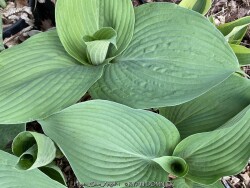

Hosta by far is the most popular and well-known shade plant in the United States. Many thousands of cultivars exist from original species native to China, Japan, and other forested areas in Asia. Hosta foliage arrises from a clump-forming root system and is often large and dramatic with many types of variegation. Flowers, born on tall stocks ranging in shades of white and purple, are equally attractive. Hostas grow best in rich, well-drained soils in full to partial shade. In Eastern Kansas with our average 40 inches of average rainfall, plants are drought tolerant if established in moisture-retentive high-quality soil. Dry-shade areas are best avoided. Afternoon sun with temperatures over 95 degrees F but likely burn the tips of hosta foliage rendering them unattractive for the rest of the year. There is no secondary growth by late summer after flowering and after buds have been set for next year. In northern parts of the country, hostas can handle full sun. In the Southern part of their range further South than zone 7, hosta can really struggle through the long summer heat unless conditions are perfect. Rabbits, deer, slugs, and snails can be a problem generally on small or un-established plants. Large-leaf robust varieties seem to outgrow browsing predators better than small dainty varieties. Methods of control are effective ranging from cages to deer repellents. Generally, a large established planting of hostas will be there for decades gradually getting thicker and denser without a need to divide. Many plantings have been in our display garden for 15-20 years with no weeds ever trying to grow in the shade of the foliage. Hosta foliage is susceptible to late spring freezes so try to cover if possible. During the Easter freeze of April, 2007, thousands of hosta were killed to the ground in eastern Kansas but all returned successfully by May from secondary buds. Hosta's newly unfurling foliage is considered edible when cooked like asparagus or eaten raw in salads. Hosta 'Blue Angel' features giant, heart-shaped blue-green heavily textured leaves under dense hyacinth-like white flowers.
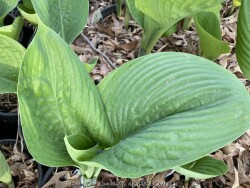

Hosta by far is the most popular and well-known shade plant in the United States. Many thousands of cultivars exist from original species native to China, Japan, and other forested areas in Asia. Hosta foliage arrises from a clump-forming root system and is often large and dramatic with many types of variegation. Flowers, born on tall stocks ranging in shades of white and purple, are equally attractive. Hostas grow best in rich, well-drained soils in full to partial shade. In Eastern Kansas with our average 40 inches of average rainfall, plants are drought tolerant if established in moisture-retentive high-quality soil. Dry-shade areas are best avoided. Afternoon sun with temperatures over 95 degrees F but likely burn the tips of hosta foliage rendering them unattractive for the rest of the year. There is no secondary growth by late summer after flowering and after buds have been set for next year. In northern parts of the country, hostas can handle full sun. In the Southern part of their range further South than zone 7, hosta can really struggle through the long summer heat unless conditions are perfect. Rabbits, deer, slugs, and snails can be a problem generally on small or un-established plants. Large-leaf robust varieties seem to outgrow browsing predators better than small dainty varieties. Methods of control are effective ranging from cages to deer repellents. Generally, a large established planting of hostas will be there for decades gradually getting thicker and denser without a need to divide. Many plantings have been in our display garden for 15-20 years with no weeds ever trying to grow in the shade of the foliage. Hosta foliage is susceptible to late spring freezes so try to cover if possible. During the Easter freeze of April, 2007, thousands of hosta were killed to the ground in eastern Kansas but all returned successfully by May from secondary buds. Hosta's newly unfurling foliage is considered edible when cooked like asparagus or eaten raw in salads. Hosta 'Blue Angel' features giant, heart-shaped blue-green heavily textured leaves under dense hyacinth-like white flowers.
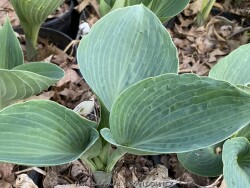

Hosta by far is the most popular and well-known shade plant in the United States. Many thousands of cultivars exist from original species native to China, Japan, and other forested areas in Asia. Hosta foliage arrises from a clump-forming root system and is often large and dramatic with many types of variegation. Flowers, born on tall stocks ranging in shades of white and purple, are equally attractive. Hostas grow best in rich, well-drained soils in full to partial shade. In Eastern Kansas with our average 40 inches of average rainfall, plants are drought tolerant if established in moisture-retentive high-quality soil. Dry-shade areas are best avoided. Afternoon sun with temperatures over 95 degrees F but likely burn the tips of hosta foliage rendering them unattractive for the rest of the year. There is no secondary growth by late summer after flowering and after buds have been set for next year. In northern parts of the country, hostas can handle full sun. In the Southern part of their range further South than zone 7, hosta can really struggle through the long summer heat unless conditions are perfect. Rabbits, deer, slugs, and snails can be a problem generally on small or un-established plants. Large-leaf robust varieties seem to outgrow browsing predators better than small dainty varieties. Methods of control are effective ranging from cages to deer repellents. Generally, a large established planting of hostas will be there for decades gradually getting thicker and denser without a need to divide. Many plantings have been in our display garden for 15-20 years with no weeds ever trying to grow in the shade of the foliage. Hosta foliage is susceptible to late spring freezes so try to cover if possible. During the Easter freeze of April, 2007, thousands of hosta were killed to the ground in eastern Kansas but all returned successfully by May from secondary buds. Hosta's newly unfurling foliage is considered edible when cooked like asparagus or eaten raw in salads. Hosta 'Bulletproof' has extremely thick blue leaves that look good all season: very resistant to slugs and snails. Sport of 'Halcyon'
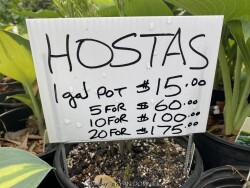

Hosta by far is the most popular and well-known shade plant in the United States. Many thousands of cultivars exist from original species native to China, Japan, and other forested areas in Asia. Hosta foliage arrises from a clump-forming root system and is often large and dramatic with many types of variegation. Flowers, born on tall stocks ranging in shades of white and purple, are equally attractive. Hostas grow best in rich, well-drained soils in full to partial shade. In Eastern Kansas with our average 40 inches of average rainfall, plants are drought tolerant if established in moisture-retentive high-quality soil. Dry-shade areas are best avoided. Afternoon sun with temperatures over 95 degrees F but likely burn the tips of hosta foliage rendering them unattractive for the rest of the year. There is no secondary growth by late summer after flowering and after buds have been set for next year. In northern parts of the country, hostas can handle full sun. In the Southern part of their range further South than zone 7, hosta can really struggle through the long summer heat unless conditions are perfect. Rabbits, deer, slugs, and snails can be a problem generally on small or un-established plants. Large-leaf robust varieties seem to outgrow browsing predators better than small dainty varieties. Methods of control are effective ranging from cages to deer repellents. Generally, a large established planting of hostas will be there for decades gradually getting thicker and denser without a need to divide. Many plantings have been in our display garden for 15-20 years with no weeds ever trying to grow in the shade of the foliage. Hosta foliage is susceptible to late spring freezes so try to cover if possible. During the Easter freeze of April, 2007, thousands of hosta were killed to the ground in eastern Kansas but all returned successfully by May from secondary buds. Hosta's newly unfurling foliage is considered edible when cooked like asparagus or eaten raw in salads. Hosta 'Dream Queen' is a medium; a slightly smaller version of Great Expectations with improved bold variegation. Puckered heart-shaped leaves have wider blue-green margin and creamy yellow centers; white blossoms; excellent substance. Fast grower with more sun tolerance
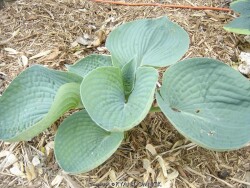

Hosta by far is the most popular and well-known shade plant in the United States. Many thousands of cultivars exist from original species native to China, Japan, and other forested areas in Asia. Hosta foliage arrises from a clump-forming root system and is often large and dramatic with many types of variegation. Flowers, born on tall stocks ranging in shades of white and purple, are equally attractive. Hostas grow best in rich, well-drained soils in full to partial shade. In Eastern Kansas with our average 40 inches of average rainfall, plants are drought tolerant if established in moisture-retentive high-quality soil. Dry-shade areas are best avoided. Afternoon sun with temperatures over 95 degrees F but likely burn the tips of hosta foliage rendering them unattractive for the rest of the year. There is no secondary growth by late summer after flowering and after buds have been set for next year. In northern parts of the country, hostas can handle full sun. In the Southern part of their range further South than zone 7, hosta can really struggle through the long summer heat unless conditions are perfect. Rabbits, deer, slugs, and snails can be a problem generally on small or un-established plants. Large-leaf robust varieties seem to outgrow browsing predators better than small dainty varieties. Methods of control are effective ranging from cages to deer repellents. Generally, a large established planting of hostas will be there for decades gradually getting thicker and denser without a need to divide. Many plantings have been in our display garden for 15-20 years with no weeds ever trying to grow in the shade of the foliage. Hosta foliage is susceptible to late spring freezes so try to cover if possible. During the Easter freeze of April, 2007, thousands of hosta were killed to the ground in eastern Kansas but all returned successfully by May from secondary buds. Hosta's newly unfurling foliage is considered edible when cooked like asparagus or eaten raw in salads. Hosta 'Earth Angel' Giant; this spectacular new sport from Blue Angel has huge blue-green pointed leaves with wide creamy white margins. Thick leaves have good substance and deep attractive ribs. Pale lavender flowers bloom midsummer. Very impressive mature clumps can reach 5' across.
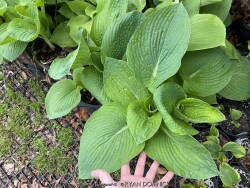

Hosta by far is the most popular and well-known shade plant in the United States. Many thousands of cultivars exist from original species native to China, Japan, and other forested areas in Asia. Hosta foliage arrises from a clump-forming root system and is often large and dramatic with many types of variegation. Flowers, born on tall stocks ranging in shades of white and purple, are equally attractive. Hostas grow best in rich, well-drained soils in full to partial shade. In Eastern Kansas with our average 40 inches of average rainfall, plants are drought tolerant if established in moisture-retentive high-quality soil. Dry-shade areas are best avoided. Afternoon sun with temperatures over 95 degrees F but likely burn the tips of hosta foliage rendering them unattractive for the rest of the year. There is no secondary growth by late summer after flowering and after buds have been set for next year. In northern parts of the country, hostas can handle full sun. In the Southern part of their range further South than zone 7, hosta can really struggle through the long summer heat unless conditions are perfect. Rabbits, deer, slugs, and snails can be a problem generally on small or un-established plants. Large-leaf robust varieties seem to outgrow browsing predators better than small dainty varieties. Methods of control are effective ranging from cages to deer repellents. Generally, a large established planting of hostas will be there for decades gradually getting thicker and denser without a need to divide. Many plantings have been in our display garden for 15-20 years with no weeds ever trying to grow in the shade of the foliage. Hosta foliage is susceptible to late spring freezes so try to cover if possible. During the Easter freeze of April, 2007, thousands of hosta were killed to the ground in eastern Kansas but all returned successfully by May from secondary buds. Hosta's newly unfurling foliage is considered edible when cooked like asparagus or eaten raw in salads. Hosta 'Elegans' is an older variety with giant heart-shaped heavily puckered blue-gray leaves are pest resistant. Near white flowers on short scapes.
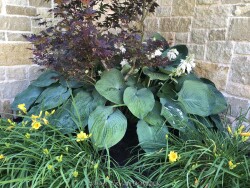

Hosta by far is the most popular and well-known shade plant in the United States. Many thousands of cultivars exist from original species native to China, Japan, and other forested areas in Asia. Hosta foliage arrises from a clump-forming root system and is often large and dramatic with many types of variegation. Flowers, born on tall stocks ranging in shades of white and purple, are equally attractive. Hostas grow best in rich, well-drained soils in full to partial shade. In Eastern Kansas with our average 40 inches of average rainfall, plants are drought tolerant if established in moisture-retentive high-quality soil. Dry-shade areas are best avoided. Afternoon sun with temperatures over 95 but likely burn the tips of hosta foliage rendering them unattractive for the rest of the year. There is no secondary growth by late summer after flowering and after buds have been set for next year. In northern parts of the country, hostas can handle full sun. In the Southern part of their range further South than zone 7, hosta can really struggle through the long summer heat unless conditions are perfect. Rabbits, deer, slugs, and snails can be a problem generally on small or un-established plants. Large-leaf robust varieties seem to outgrow browsing predators better than small dainty varieties. Methods of control are effective ranging from cages to deer repellents. Generally, a large established planting of hostas will be there for decades gradually getting thicker and denser without a need to divide. Many plantings have been in our display garden for 15-20 years with no weeds ever trying to grow in the shade of the foliage. Hosta foliage is susceptible to late spring freezes so try to cover if possible. During the Easter freeze of April, 2007, thousands of hosta were killed to the ground in eastern Kansas but all returned successfully by May from secondary buds. Hosta's newly unfurling foliage is considered edible when cooked like asparagus or eaten raw in salads. Shadowland® 'Empress Wu' is the largest known hosta available! This massive plant forms a gigantic upright mound of huge, thick, dark green leaves topped with pale reddish violet flowers. It will make a fantastic statement in your shade garden! All Proven Winners® plants are legally propagated, healthy and vigorous, true to name, and tagged with color pictures and growing information.


Hosta by far is the most popular and well-known shade plant in the United States. Many thousands of cultivars exist from original species native to China, Japan, and other forested areas in Asia. Hosta foliage arrises from a clump-forming root system and is often large and dramatic with many types of variegation. Flowers, born on tall stocks ranging in shades of white and purple, are equally attractive. Hostas grow best in rich, well-drained soils in full to partial shade. In Eastern Kansas with our average 40 inches of average rainfall, plants are drought tolerant if established in moisture-retentive high-quality soil. Dry-shade areas are best avoided. Afternoon sun with temperatures over 95 degrees F but likely burn the tips of hosta foliage rendering them unattractive for the rest of the year. There is no secondary growth by late summer after flowering and after buds have been set for next year. In northern parts of the country, hostas can handle full sun. In the Southern part of their range further South than zone 7, hosta can really struggle through the long summer heat unless conditions are perfect. Rabbits, deer, slugs, and snails can be a problem generally on small or un-established plants. Large-leaf robust varieties seem to outgrow browsing predators better than small dainty varieties. Methods of control are effective ranging from cages to deer repellents. Generally, a large established planting of hostas will be there for decades gradually getting thicker and denser without a need to divide. Many plantings have been in our display garden for 15-20 years with no weeds ever trying to grow in the shade of the foliage. Hosta foliage is susceptible to late spring freezes so try to cover if possible. During the Easter freeze of April, 2007, thousands of hosta were killed to the ground in eastern Kansas but all returned successfully by May from secondary buds. Hosta's newly unfurling foliage is considered edible when cooked like asparagus or eaten raw in salads. Hosta 'Halcyon' is a medium height cultivar. It features spearhead-shaped chalky-blue leaves with heavy ribbing and pale lavender flowers. Thick substance, pest resistant, tolerates partial sun.
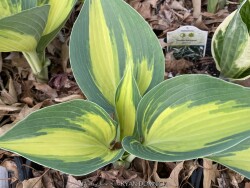

Hosta by far is the most popular and well-known shade plant in the United States. Many thousands of cultivars exist from original species native to China, Japan, and other forested areas in Asia. Hosta foliage arrises from a clump-forming root system and is often large and dramatic with many types of variegation. Flowers, born on tall stocks ranging in shades of white and purple, are equally attractive. Hostas grow best in rich, well-drained soils in full to partial shade. In Eastern Kansas with our average 40 inches of average rainfall, plants are drought tolerant if established in moisture-retentive high-quality soil. Dry-shade areas are best avoided. Afternoon sun with temperatures over 95 degrees F but likely burn the tips of hosta foliage rendering them unattractive for the rest of the year. There is no secondary growth by late summer after flowering and after buds have been set for next year. In northern parts of the country, hostas can handle full sun. In the Southern part of their range further South than zone 7, hosta can really struggle through the long summer heat unless conditions are perfect. Rabbits, deer, slugs, and snails can be a problem generally on small or un-established plants. Large-leaf robust varieties seem to outgrow browsing predators better than small dainty varieties. Methods of control are effective ranging from cages to deer repellents. Generally, a large established planting of hostas will be there for decades gradually getting thicker and denser without a need to divide. Many plantings have been in our display garden for 15-20 years with no weeds ever trying to grow in the shade of the foliage. Hosta foliage is susceptible to late spring freezes so try to cover if possible. During the Easter freeze of April, 2007, thousands of hosta were killed to the ground in eastern Kansas but all returned successfully by May from secondary buds. Hosta's newly unfurling foliage is considered edible when cooked like asparagus or eaten raw in salads. Hosta 'June' is a medium height cultivar. It features small (medium) spearhead-shaped leaves with irregular blue-green edges, chartreuse centers fading to white; lavender flowers. Heavy substance, slug resistant; tolerates partial sun.


Hosta by far is the most popular and well-known shade plant in the United States. Many thousands of cultivars exist from original species native to China, Japan, and other forested areas in Asia. Hosta foliage arrises from a clump-forming root system and is often large and dramatic with many types of variegation. Flowers, born on tall stocks ranging in shades of white and purple, are equally attractive. Hostas grow best in rich, well-drained soils in full to partial shade. In Eastern Kansas with our average 40 inches of average rainfall, plants are drought tolerant if established in moisture-retentive high-quality soil. Dry-shade areas are best avoided. Afternoon sun with temperatures over 95 degrees F but likely burn the tips of hosta foliage rendering them unattractive for the rest of the year. There is no secondary growth by late summer after flowering and after buds have been set for next year. In northern parts of the country, hostas can handle full sun. In the Southern part of their range further South than zone 7, hosta can really struggle through the long summer heat unless conditions are perfect. Rabbits, deer, slugs, and snails can be a problem generally on small or un-established plants. Large-leaf robust varieties seem to outgrow browsing predators better than small dainty varieties. Methods of control are effective ranging from cages to deer repellents. Generally, a large established planting of hostas will be there for decades gradually getting thicker and denser without a need to divide. Many plantings have been in our display garden for 15-20 years with no weeds ever trying to grow in the shade of the foliage. Hosta foliage is susceptible to late spring freezes so try to cover if possible. During the Easter freeze of April, 2007, thousands of hosta were killed to the ground in eastern Kansas but all returned successfully by May from secondary buds. Hosta's newly unfurling foliage is considered edible when cooked like asparagus or eaten raw in salads. Hosta 'Krossa Regal' is a large to giant hosta that grows in an upright, vase-shaped habit. Foliage is thick, waxy, pest resistant, and powdery-blue. Trumpet-shaped, lavender flowers bloom in mid to late summer on tall stalks.
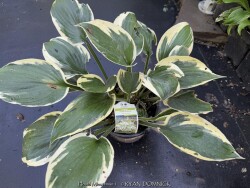

Hosta by far is the most popular and well-known shade plant in the United States. Many thousands of cultivars exist from original species native to China, Japan, and other forested areas in Asia. Hosta foliage arrises from a clump-forming root system and is often large and dramatic with many types of variegation. Flowers, born on tall stocks ranging in shades of white and purple, are equally attractive. Hostas grow best in rich, well-drained soils in full to partial shade. In Eastern Kansas with our average 40 inches of average rainfall, plants are drought tolerant if established in moisture-retentive high-quality soil. Dry-shade areas are best avoided. Afternoon sun with temperatures over 95 degrees F but likely burn the tips of hosta foliage rendering them unattractive for the rest of the year. There is no secondary growth by late summer after flowering and after buds have been set for next year. In northern parts of the country, hostas can handle full sun. In the Southern part of their range further South than zone 7, hosta can really struggle through the long summer heat unless conditions are perfect. Rabbits, deer, slugs, and snails can be a problem generally on small or un-established plants. Large-leaf robust varieties seem to outgrow browsing predators better than small dainty varieties. Methods of control are effective ranging from cages to deer repellents. Generally, a large established planting of hostas will be there for decades gradually getting thicker and denser without a need to divide. Many plantings have been in our display garden for 15-20 years with no weeds ever trying to grow in the shade of the foliage. Hosta foliage is susceptible to late spring freezes so try to cover if possible. During the Easter freeze of April, 2007, thousands of hosta were killed to the ground in eastern Kansas but all returned successfully by May from secondary buds. Hosta's newly unfurling foliage is considered edible when cooked like asparagus or eaten raw in salads.
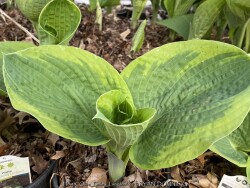

Hosta by far is the most popular and well-known shade plant in the United States. Many thousands of cultivars exist from original species native to China, Japan, and other forested areas in Asia. Hosta foliage arrises from a clump-forming root system and is often large and dramatic with many types of variegation. Flowers, born on tall stocks ranging in shades of white and purple, are equally attractive. Hostas grow best in rich, well-drained soils in full to partial shade. In Eastern Kansas with our average 40 inches of average rainfall, plants are drought tolerant if established in moisture-retentive high-quality soil. Dry-shade areas are best avoided. Afternoon sun with temperatures over 95 degrees F but likely burn the tips of hosta foliage rendering them unattractive for the rest of the year. There is no secondary growth by late summer after flowering and after buds have been set for next year. In northern parts of the country, hostas can handle full sun. In the Southern part of their range further South than zone 7, hosta can really struggle through the long summer heat unless conditions are perfect. Rabbits, deer, slugs, and snails can be a problem generally on small or un-established plants. Large-leaf robust varieties seem to outgrow browsing predators better than small dainty varieties. Methods of control are effective ranging from cages to deer repellents. Generally, a large established planting of hostas will be there for decades gradually getting thicker and denser without a need to divide. Many plantings have been in our display garden for 15-20 years with no weeds ever trying to grow in the shade of the foliage. Hosta foliage is susceptible to late spring freezes so try to cover if possible. During the Easter freeze of April, 2007, thousands of hosta were killed to the ground in eastern Kansas but all returned successfully by May from secondary buds. Hosta's newly unfurling foliage is considered edible when cooked like asparagus or eaten raw in salads. Hosta 'Olive Bailey Langdon' is a large variety. Considered an improved Frances Williams with better color and less prone to burning. Large rounded leaves with powder blue centers and wide irregular gold margins under white blossoms; heavily corrugated with thick substance.
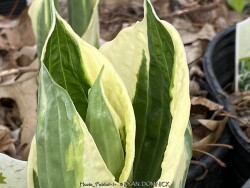

Hosta by far is the most popular and well-known shade plant in the United States. Many thousands of cultivars exist from original species native to China, Japan, and other forested areas in Asia. Hosta foliage arrises from a clump-forming root system and is often large and dramatic with many types of variegation. Flowers, born on tall stocks ranging in shades of white and purple, are equally attractive. Hostas grow best in rich, well-drained soils in full to partial shade. In Eastern Kansas with our average 40 inches of average rainfall, plants are drought tolerant if established in moisture-retentive high-quality soil. Dry-shade areas are best avoided. Afternoon sun with temperatures over 95 degrees F but likely burn the tips of hosta foliage rendering them unattractive for the rest of the year. There is no secondary growth by late summer after flowering and after buds have been set for next year. In northern parts of the country, hostas can handle full sun. In the Southern part of their range further South than zone 7, hosta can really struggle through the long summer heat unless conditions are perfect. Rabbits, deer, slugs, and snails can be a problem generally on small or un-established plants. Large-leaf robust varieties seem to outgrow browsing predators better than small dainty varieties. Methods of control are effective ranging from cages to deer repellents. Generally, a large established planting of hostas will be there for decades gradually getting thicker and denser without a need to divide. Many plantings have been in our display garden for 15-20 years with no weeds ever trying to grow in the shade of the foliage. Hosta foliage is susceptible to late spring freezes so try to cover if possible. During the Easter freeze of April, 2007, thousands of hosta were killed to the ground in eastern Kansas but all returned successfully by May from secondary buds. Hosta's newly unfurling foliage is considered edible when cooked like asparagus or eaten raw in salads.


Hosta by far is the most popular and well-known shade plant in the United States. Many thousands of cultivars exist from original species native to China, Japan, and other forested areas in Asia. Hosta foliage arrises from a clump-forming root system and is often large and dramatic with many types of variegation. Flowers, born on tall stocks ranging in shades of white and purple, are equally attractive. Hostas grow best in rich, well-drained soils in full to partial shade. In Eastern Kansas with our average 40 inches of average rainfall, plants are drought tolerant if established in moisture-retentive high-quality soil. Dry-shade areas are best avoided. Afternoon sun with temperatures over 95 degrees F but likely burn the tips of hosta foliage rendering them unattractive for the rest of the year. There is no secondary growth by late summer after flowering and after buds have been set for next year. In northern parts of the country, hostas can handle full sun. In the Southern part of their range further South than zone 7, hosta can really struggle through the long summer heat unless conditions are perfect. Rabbits, deer, slugs, and snails can be a problem generally on small or un-established plants. Large-leaf robust varieties seem to outgrow browsing predators better than small dainty varieties. Methods of control are effective ranging from cages to deer repellents. Generally, a large established planting of hostas will be there for decades gradually getting thicker and denser without a need to divide. Many plantings have been in our display garden for 15-20 years with no weeds ever trying to grow in the shade of the foliage. Hosta foliage is susceptible to late spring freezes so try to cover if possible. During the Easter freeze of April, 2007, thousands of hosta were killed to the ground in eastern Kansas but all returned successfully by May from secondary buds. Hosta's newly unfurling foliage is considered edible when cooked like asparagus or eaten raw in salads. Hosta 'June' is a medium height cultivar. It features small (medium) spearhead-shaped leaves with irregular blue-green edges, chartreuse centers fading to white; lavender flowers. Heavy substance, slug resistant; tolerates partial sun.
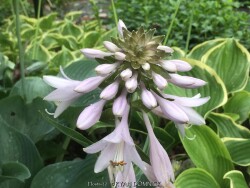

Hosta by far is the most popular and well-known shade plant in the United States. Many thousands of cultivars exist from original species native to China, Japan, and other forested areas in Asia. Hosta foliage arrises from a clump-forming root system and is often large and dramatic with many types of variegation. Flowers, born on tall stocks ranging in shades of white and purple, are equally attractive. Hostas grow best in rich, well-drained soils in full to partial shade. In Eastern Kansas with our average 40 inches of average rainfall, plants are drought tolerant if established in moisture-retentive high-quality soil. Dry-shade areas are best avoided. Afternoon sun with temperatures over 95 degrees F but likely burn the tips of hosta foliage rendering them unattractive for the rest of the year. There is no secondary growth by late summer after flowering and after buds have been set for next year. In northern parts of the country, hostas can handle full sun. In the Southern part of their range further South than zone 7, hosta can really struggle through the long summer heat unless conditions are perfect. Rabbits, deer, slugs, and snails can be a problem generally on small or un-established plants. Large-leaf robust varieties seem to outgrow browsing predators better than small dainty varieties. Methods of control are effective ranging from cages to deer repellents. Generally, a large established planting of hostas will be there for decades gradually getting thicker and denser without a need to divide. Many plantings have been in our display garden for 15-20 years with no weeds ever trying to grow in the shade of the foliage. Hosta foliage is susceptible to late spring freezes so try to cover if possible. During the Easter freeze of April, 2007, thousands of hosta were killed to the ground in eastern Kansas but all returned successfully by May from secondary buds. Hosta's newly unfurling foliage is considered edible when cooked like asparagus or eaten raw in salads. Hosta 'Sagae' is a large, vase-shaped hosta cultivar. It features a medium to tall mound of large of variegated frosty blue-green foliage. Foliage mound will typically spread over time to 36" wide or more.
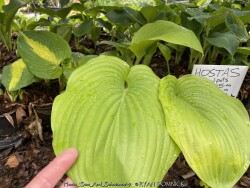

Hosta by far is the most popular and well-known shade plant in the United States. Many thousands of cultivars exist from original species native to China, Japan, and other forested areas in Asia. Hosta foliage arrises from a clump-forming root system and is often large and dramatic with many types of variegation. Flowers, born on tall stocks ranging in shades of white and purple, are equally attractive. Hostas grow best in rich, well-drained soils in full to partial shade. In Eastern Kansas with our average 40 inches of average rainfall, plants are drought tolerant if established in moisture-retentive high-quality soil. Dry-shade areas are best avoided. Afternoon sun with temperatures over 95 degrees F but likely burn the tips of hosta foliage rendering them unattractive for the rest of the year. There is no secondary growth by late summer after flowering and after buds have been set for next year. In northern parts of the country, hostas can handle full sun. In the Southern part of their range further South than zone 7, hosta can really struggle through the long summer heat unless conditions are perfect. Rabbits, deer, slugs, and snails can be a problem generally on small or un-established plants. Large-leaf robust varieties seem to outgrow browsing predators better than small dainty varieties. Methods of control are effective ranging from cages to deer repellents. Generally, a large established planting of hostas will be there for decades gradually getting thicker and denser without a need to divide. Many plantings have been in our display garden for 15-20 years with no weeds ever trying to grow in the shade of the foliage. Hosta foliage is susceptible to late spring freezes so try to cover if possible. During the Easter freeze of April, 2007, thousands of hosta were killed to the ground in eastern Kansas but all returned successfully by May from secondary buds. Hosta's newly unfurling foliage is considered edible when cooked like asparagus or eaten raw in salads. Hosta 'Sum and Substance' is a giant! It features huge chartreuse round leaves with heavy puckering, very thick substance; slug resistant. Vigorous; requires some sun to enhance its golden color. Lavender flowers on tall 50" scapes.


Hosta by far is the most popular and well-known shade plant in the United States. Many thousands of cultivars exist from original species native to China, Japan, and other forested areas in Asia. Hosta foliage arrises from a clump-forming root system and is often large and dramatic with many types of variegation. Flowers, born on tall stocks ranging in shades of white and purple, are equally attractive. Hostas grow best in rich, well-drained soils in full to partial shade. In Eastern Kansas with our average 40 inches of average rainfall, plants are drought tolerant if established in moisture-retentive high-quality soil. Dry-shade areas are best avoided. Afternoon sun with temperatures over 95 degrees F but likely burn the tips of hosta foliage rendering them unattractive for the rest of the year. There is no secondary growth by late summer after flowering and after buds have been set for next year. In northern parts of the country, hostas can handle full sun. In the Southern part of their range further South than zone 7, hosta can really struggle through the long summer heat unless conditions are perfect. Rabbits, deer, slugs, and snails can be a problem generally on small or un-established plants. Large-leaf robust varieties seem to outgrow browsing predators better than small dainty varieties. Methods of control are effective ranging from cages to deer repellents. Generally, a large established planting of hostas will be there for decades gradually getting thicker and denser without a need to divide. Many plantings have been in our display garden for 15-20 years with no weeds ever trying to grow in the shade of the foliage. Hosta foliage is susceptible to late spring freezes so try to cover if possible. During the Easter freeze of April, 2007, thousands of hosta were killed to the ground in eastern Kansas but all returned successfully by May from secondary buds. Hosta's newly unfurling foliage is considered edible when cooked like asparagus or eaten raw in salads. Hosta 'T-Rex' is a giant. It forms absolutely huge clumps of blue-green leaves measuring 18" long and 14"wide! Wonderful puckering and deep veins add interest, a focal point for any garden. Near white flowers.
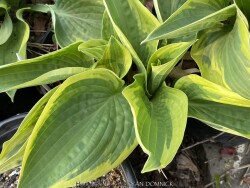

Hosta by far is the most popular and well-known shade plant in the United States. Many thousands of cultivars exist from original species native to China, Japan, and other forested areas in Asia. Hosta foliage arrises from a clump-forming root system and is often large and dramatic with many types of variegation. Flowers, born on tall stocks ranging in shades of white and purple, are equally attractive. Hostas grow best in rich, well-drained soils in full to partial shade. In Eastern Kansas with our average 40 inches of average rainfall, plants are drought tolerant if established in moisture-retentive high-quality soil. Dry-shade areas are best avoided. Afternoon sun with temperatures over 95 degrees F but likely burn the tips of hosta foliage rendering them unattractive for the rest of the year. There is no secondary growth by late summer after flowering and after buds have been set for next year. In northern parts of the country, hostas can handle full sun. In the Southern part of their range further South than zone 7, hosta can really struggle through the long summer heat unless conditions are perfect. Rabbits, deer, slugs, and snails can be a problem generally on small or un-established plants. Large-leaf robust varieties seem to outgrow browsing predators better than small dainty varieties. Methods of control are effective ranging from cages to deer repellents. Generally, a large established planting of hostas will be there for decades gradually getting thicker and denser without a need to divide. Many plantings have been in our display garden for 15-20 years with no weeds ever trying to grow in the shade of the foliage. Hosta foliage is susceptible to late spring freezes so try to cover if possible. During the Easter freeze of April, 2007, thousands of hosta were killed to the ground in eastern Kansas but all returned successfully by May from secondary buds. Hosta's newly unfurling foliage is considered edible when cooked like asparagus or eaten raw in salads. Hosta 'Wide Brim' is a medium variety with heart-shaped green leaves with wide irregular creamy-yellow margins. Good substance with slight puckering under pale lavender flowers.
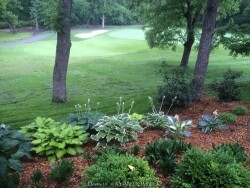

Hosta by far is the most popular and well-known shade plant in the United States. Many thousands of cultivars exist from original species native to China, Japan, and other forested areas in Asia. Hosta foliage arrises from a clump-forming root system and is often large and dramatic with many types of variegation. Flowers, born on tall stocks ranging in shades of white and purple, are equally attractive. Hostas grow best in rich, well-drained soils in full to partial shade. In Eastern Kansas with our average 40 inches of average rainfall, plants are drought tolerant if established in moisture-retentive high-quality soil. Dry-shade areas are best avoided. Afternoon sun with temperatures over 95 degrees F but likely burn the tips of hosta foliage rendering them unattractive for the rest of the year. There is no secondary growth by late summer after flowering and after buds have been set for next year. In northern parts of the country, hostas can handle full sun. In the Southern part of their range further South than zone 7, hosta can really struggle through the long summer heat unless conditions are perfect. Rabbits, deer, slugs, and snails can be a problem generally on small or un-established plants. Large-leaf robust varieties seem to outgrow browsing predators better than small dainty varieties. Methods of control are effective ranging from cages to deer repellents. Generally, a large established planting of hostas will be there for decades gradually getting thicker and denser without a need to divide. Many plantings have been in our display garden for 15-20 years with no weeds ever trying to grow in the shade of the foliage. Hosta foliage is susceptible to late spring freezes so try to cover if possible. During the Easter freeze of April, 2007, thousands of hosta were killed to the ground in eastern Kansas but all returned successfully by May from secondary buds. Hosta's newly unfurling foliage is considered edible when cooked like asparagus or eaten raw in salads.


Hosta by far is the most popular and well-known shade plant in the United States. Many thousands of cultivars exist from original species native to China, Japan, and other forested areas in Asia. Hosta foliage arrises from a clump-forming root system and is often large and dramatic with many types of variegation. Flowers, born on tall stocks ranging in shades of white and purple, are equally attractive. Hostas grow best in rich, well-drained soils in full to partial shade. In Eastern Kansas with our average 40 inches of average rainfall, plants are drought tolerant if established in moisture-retentive high-quality soil. Dry-shade areas are best avoided. Afternoon sun with temperatures over 95 degrees F but likely burn the tips of hosta foliage rendering them unattractive for the rest of the year. There is no secondary growth by late summer after flowering and after buds have been set for next year. In northern parts of the country, hostas can handle full sun. In the Southern part of their range further South than zone 7, hosta can really struggle through the long summer heat unless conditions are perfect. Rabbits, deer, slugs, and snails can be a problem generally on small or un-established plants. Large-leaf robust varieties seem to outgrow browsing predators better than small dainty varieties. Methods of control are effective ranging from cages to deer repellents. Generally, a large established planting of hostas will be there for decades gradually getting thicker and denser without a need to divide. Many plantings have been in our display garden for 15-20 years with no weeds ever trying to grow in the shade of the foliage. Hosta foliage is susceptible to late spring freezes so try to cover if possible. During the Easter freeze of April, 2007, thousands of hosta were killed to the ground in eastern Kansas but all returned successfully by May from secondary buds. Hosta's newly unfurling foliage is considered edible when cooked like asparagus or eaten raw in salads.
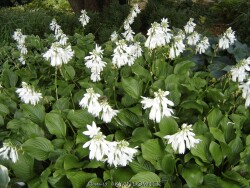

Hosta by far is the most popular and well-known shade plant in the United States. Many thousands of cultivars exist from original species native to China, Japan, and other forested areas in Asia. Hosta foliage arrises from a clump-forming root system and is often large and dramatic with many types of variegation. Flowers, born on tall stocks ranging in shades of white and purple, are equally attractive. Hostas grow best in rich, well-drained soils in full to partial shade. In Eastern Kansas with our average 40 inches of average rainfall, plants are drought tolerant if established in moisture-retentive high-quality soil. Dry-shade areas are best avoided. Afternoon sun with temperatures over 95 degrees F but likely burn the tips of hosta foliage rendering them unattractive for the rest of the year. There is no secondary growth by late summer after flowering and after buds have been set for next year. In northern parts of the country, hostas can handle full sun. In the Southern part of their range further South than zone 7, hosta can really struggle through the long summer heat unless conditions are perfect. Rabbits, deer, slugs, and snails can be a problem generally on small or un-established plants. Large-leaf robust varieties seem to outgrow browsing predators better than small dainty varieties. Methods of control are effective ranging from cages to deer repellents. Generally, a large established planting of hostas will be there for decades gradually getting thicker and denser without a need to divide. Many plantings have been in our display garden for 15-20 years with no weeds ever trying to grow in the shade of the foliage. Hosta foliage is susceptible to late spring freezes so try to cover if possible. During the Easter freeze of April, 2007, thousands of hosta were killed to the ground in eastern Kansas but all returned successfully by May from secondary buds. Hosta's newly unfurling foliage is considered edible when cooked like asparagus or eaten raw in salads. Hosta plantaginea 'Royal Standard' is an older variety that is very vigorous and tough. Robust clumps slowly spread over time. It features large glossy apple-green leaves with attractive ribbing under fragrant white flowers on 36" scapes. Very sun and drought tolerant.
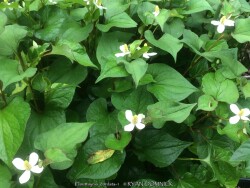

***Description for this perennial available with future update!*** Houttuynia cordata 'Salad Superfood' is also known as Green Houttuynia / Salad Superfood >>>>>This plant can also be used as a marginal aquatic plant growing in shallow water. It can also grow as a bog plant needing constantly moist soil rich in organic matter. As a rain garden plant, it will thrive is a depressed area in the landscape that collects rain water from a roof during spring and summer periods of rain but then go dormant if the water hole dries out completely.>>>>>For the home garden, the species is generally too aggressive to mix with other plants
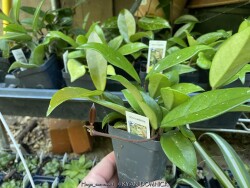

Wax Plants (Hoya sp.) have been popular house plants for decades because they are extremely long-lived, have a classic, deep green, vining foliage and produce fragrant, light pink and red star-shaped flowers. Because of their thick waxy foliage, they are often called wax plants. These tropical vines have a few requirements in order to thrive but nothing too hard. Give them bright indirect light and water only when dry. If light, temperature, and humidity are sufficient, flowers may occur. If not, then just enjoy the beautiful foliage. They are usually grown as a house plant in Kansas but can be moved outside in the summer if kept in full shade. Leaves will sunburn easily! In the wild, most species grow in dry-deciduous jungles that never get below 60 degrees F. Repotting may or may not be needed depending on how large you want the plant to grow; plants can continue to grow in the same pot for decades. If repotting, make sure to use a sharp draining but high organic cactus mix with plenty of sand and perlite. To play is safe, outside potted plants are best moved in before night temperatures get below 50 degrees F. It is important to avoid the combination of wet and cold. Potted plants are very low maintenance but watch for scale and mealybugs that may hide beneath the foliage.
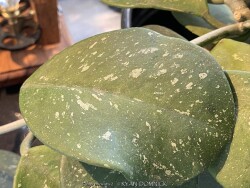

Wax Plants (Hoya sp.) have been popular house plants for decades because they are extremely long-lived, have a classic, deep green, vining foliage and produce fragrant, light pink and red star-shaped flowers. Because of their thick waxy foliage, they are often called wax plants. These tropical vines have a few requirements in order to thrive but nothing too hard. Give them bright indirect light and water only when dry. If light, temperature, and humidity are sufficient, flowers may occur. If not, then just enjoy the beautiful foliage. They are usually grown as a house plant in Kansas but can be moved outside in the summer if kept in full shade. Leaves will sunburn easily! In the wild, most species grow in dry-deciduous jungles that never get below 60 degrees F. Repotting may or may not be needed depending on how large you want the plant to grow; plants can continue to grow in the same pot for decades. If repotting, make sure to use a sharp draining but high organic cactus mix with plenty of sand and perlite. To play is safe, outside potted plants are best moved in before night temperatures get below 50 degrees F. It is important to avoid the combination of wet and cold. Potted plants are very low maintenance but watch for scale and mealybugs that may hide beneath the foliage.
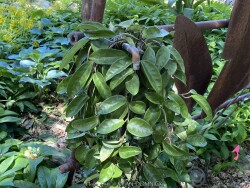

Wax Plants (Hoya sp.) have been popular house plants for decades because they are extremely long-lived, have a classic, deep green, vining foliage and produce fragrant, light pink and red star-shaped flowers. Because of their thick waxy foliage, they are often called wax plants. These tropical vines have a few requirements in order to thrive but nothing too hard. Give them bright indirect light and water only when dry. If light, temperature, and humidity are sufficient, flowers may occur. If not, then just enjoy the beautiful foliage. They are usually grown as a house plant in Kansas but can be moved outside in the summer if kept in full shade. Leaves will sunburn easily! In the wild, most species grow in dry-deciduous jungles that never get below 60 degrees F. Repotting may or may not be needed depending on how large you want the plant to grow; plants can continue to grow in the same pot for decades. If repotting, make sure to use a sharp draining but high organic cactus mix with plenty of sand and perlite. To play is safe, outside potted plants are best moved in before night temperatures get below 50 degrees F. It is important to avoid the combination of wet and cold. Potted plants are very low maintenance but watch for scale and mealybugs that may hide beneath the foliage.
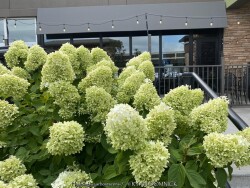

***Shrub descriptions available with future update!*** Hydrangea arborescens 'Annabelle' is also known as Annabelle Smooth Hydrangea >>>>>>>>>>>>>>Ultra cold-hardy plants from northern climates normally dislike our long hot humid summers; although we are on the Southern edge of this plants adaptability, it still survives reasonably well here. Look for a cold microclimate planting location such as East or North exposure.>>>>>
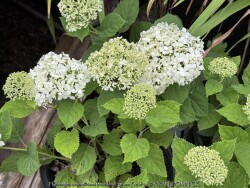

***Description for this plant available with future update!*** Hydrangea arborescens 'Incrediball Storm Proof' is also known as Incrediball Storm Proof Smooth Hydrangea >>>>> Spring Meadows nursery says "As the name suggests, Incrediball Storm Proof smooth hydrangea (Hydrangea arborescens) tackles the most common complaint people have with the genus: while other smooth hydrangeas flop, this incredibly stout and sturdy stemmed beauty holds its blooms upright during—and even after—heavy summer downpours. Though its blooms aren’t quite as gigantic as the original Incrediball®, they are so numerous and large in proportion to this compact variety that it absolutely lives up to the expectations associated with this now household name. It's a robust, vigorous, heavy bloomer with a rounder, denser habit than other smooth hydrangeas."


***Description for this plant available with future update!*** Hydrangea arborescens 'Incrediball' is also known as Incrediball Smooth Hydrangea >>>>> Spring Meadows nursery says "Literally, a huge improvement over 'Annabelle'! Our goal in creating Incrediball® hydrangea was to develop a non-flopping version of 'Annabelle.' What we ultimately selected, though, was even better: a powerhouse of a plant that not only has strong, sturdy, supportive stems, but also extra large flowers. On mature plants, they can become as large as basketballs! Blooms age to a beautiful jade green through summer and fall. Don't let its good looks fool you, though - this North American native is super hardy and tough as nails."
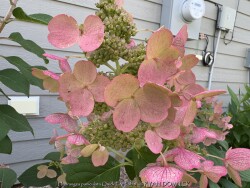

Quick Fire Fab® Panicle Hydrangea (Hydrangea paniculata 'Quick Fire Fab') is the first to bloom! Quick Fire blooms about a month before any other panicle hydrangea. Flowers open pure white then turn pink, and will be an extremely dark rosy-pink in the fall. The flower color on Quick Fire hydrangea is not affected by soil pH. Blooms on this super-hardy and easy to grow hydrangea are produced on new wood, which means that you will see flowers even after even the harshest winters. Beautiful for use as a cut (fresh or dried) flower. Unlike other panicle hydrangeas, Quick Fire Fab also has excellent fall foliage color for a final hurrah before winter. This is a very hardy flowering shrub good for full sun locations - the hotter your climate, however, the more shade the plant will require. Good for groupings and in mass plantings, shrub and perennial borders, as a specimen, a screen or a hedge. Panicle hydrangeas like Quick Fire Fab are very easy to care for. They can grow in most soils, provided they are well-drained. Panicle hydrangeas bloom on new wood, which means they can be pruned in spring and will still bloom that season. We recommend cutting them back by about one-third their total height in early spring, just as the new growth is beginning to emerge on the stems. This will serve to remove the spent blooms and ensure that the season's growth comes from the heavier, thicker buds further down the plant. If blooms do not age to pink and red, this indicates that the plant is either in too much shade, that it experienced drought stress, or that night time temperatures were unusually high. In Eastern Kansas, this cultivar performs reasonably well. Heat and drought are tolerated if in morning sun. In full sun provide ample water and expect some leaf burn if summer temperatures exceed 100 degrees F. Cold tolerance is no problem. No disease or pest problems. All Proven Winners® plants are legally propagated, healthy and vigorous, true to name, and tagged with color pictures and growing information.
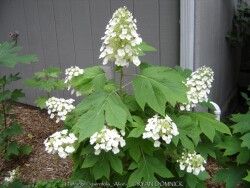

***Shrub descriptions available with future update!*** Hydrangea quercifolia 'Alice' is also known as Alice Oakleaf Hydrangea >>>>>>>>>>>>Oakleaf hydrangea (Hydrangea quercifolia) is a large coarse-textured deciduous shrub growing to 3-10 feet tall with an open crown native to the southeastern United States. Cone-shaped flower clusters emerge bright white in mid-summer. Flowers age to progressively darker shades of pink and by autumn and become persistent dried flower-heads in winter. The leaves are dark green on top and silvery-white underneath. Plants in shade have larger leaves than those grown in sun. In sun, if drought stress occurs, foliage becomes tattered, burnt, and yellowish; ruining potential fall color. The leaves of healthy plants turn rich shades of red, bronze and purple in autumn that persist until about 25 degrees F usually into late November in Kansas. The plant slowly sprouts shoots from underground stolons and often grows in colonies in ideal conditions but this is rare in Kansas. Young stems are covered in a felt-like light brown bark while the larger stems develop an attractive cinnamon-tan-orange bark that shreds and peels in thin flakes. Hydrangea quercifolia is best grown in rich, medium moisture, well-drained soils in part shade. Drought and full sun tolerance are average but greatly improved with rich, moisture-retentive foresty soils. Plant near gutter downspouts for an extra boost of water. It will tolerate drought, but may not flower. In Eastern Kansas, Cold tolerance is no problem. No significant disease or pest problems. Of all the hydrangeas, this is probably the toughest! Several improved cultivars have been developed.
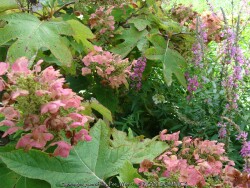

***Shrub descriptions available with future update!*** Hydrangea quercifolia 'Ruby Slippers' is also known as Ruby Slippers Dwarf Oakleaf Hydrangea >>>>>>>>>>>>Oakleaf hydrangea (Hydrangea quercifolia) is a large coarse-textured deciduous shrub growing to 3-10 feet tall with an open crown native to the southeastern United States. Cone-shaped flower clusters emerge bright white in mid-summer. Flowers age to progressively darker shades of pink and by autumn and become persistent dried flower-heads in winter. The leaves are dark green on top and silvery-white underneath. Plants in shade have larger leaves than those grown in sun. In sun, if drought stress occurs, foliage becomes tattered, burnt, and yellowish; ruining potential fall color. The leaves of healthy plants turn rich shades of red, bronze and purple in autumn that persist until about 25 degrees F usually into late November in Kansas. The plant slowly sprouts shoots from underground stolons and often grows in colonies in ideal conditions but this is rare in Kansas. Young stems are covered in a felt-like light brown bark while the larger stems develop an attractive cinnamon-tan-orange bark that shreds and peels in thin flakes. Hydrangea quercifolia is best grown in rich, medium moisture, well-drained soils in part shade. Drought and full sun tolerance are average but greatly improved with rich, moisture-retentive foresty soils. Plant near gutter downspouts for an extra boost of water. It will tolerate drought, but may not flower. In Eastern Kansas, Cold tolerance is no problem. No significant disease or pest problems. Of all the hydrangeas, this is probably the toughest! Several improved cultivars have been developed.
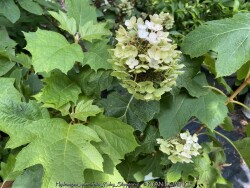

***Shrub descriptions available with future update!*** Hydrangea quercifolia 'Ruby Slippers' (small) is also known as Ruby Slippers Dwarf Oakleaf Hydrangea (small) >>>>>>>>>>>>Oakleaf hydrangea (Hydrangea quercifolia) is a large coarse-textured deciduous shrub growing to 3-10 feet tall with an open crown native to the southeastern United States. Cone-shaped flower clusters emerge bright white in mid-summer. Flowers age to progressively darker shades of pink and by autumn and become persistent dried flower-heads in winter. The leaves are dark green on top and silvery-white underneath. Plants in shade have larger leaves than those grown in sun. In sun, if drought stress occurs, foliage becomes tattered, burnt, and yellowish; ruining potential fall color. The leaves of healthy plants turn rich shades of red, bronze and purple in autumn that persist until about 25 degrees F usually into late November in Kansas. The plant slowly sprouts shoots from underground stolons and often grows in colonies in ideal conditions but this is rare in Kansas. Young stems are covered in a felt-like light brown bark while the larger stems develop an attractive cinnamon-tan-orange bark that shreds and peels in thin flakes. Hydrangea quercifolia is best grown in rich, medium moisture, well-drained soils in part shade. Drought and full sun tolerance are average but greatly improved with rich, moisture-retentive foresty soils. Plant near gutter downspouts for an extra boost of water. It will tolerate drought, but may not flower. In Eastern Kansas, Cold tolerance is no problem. No significant disease or pest problems. Of all the hydrangeas, this is probably the toughest! Several improved cultivars have been developed.
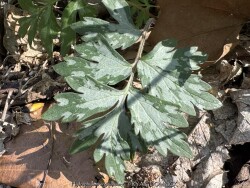

***Description for this plant available with future update!*** Hydrophyllum virginianum is also known as Virginia Waterleaf.


***Shrub descriptions available with future update!***Sunburst Hypericum, is also known as Hypericum frondosum 'Sunburst'